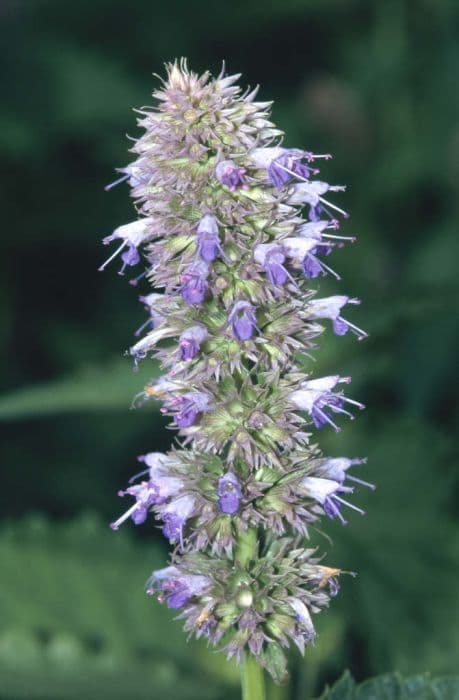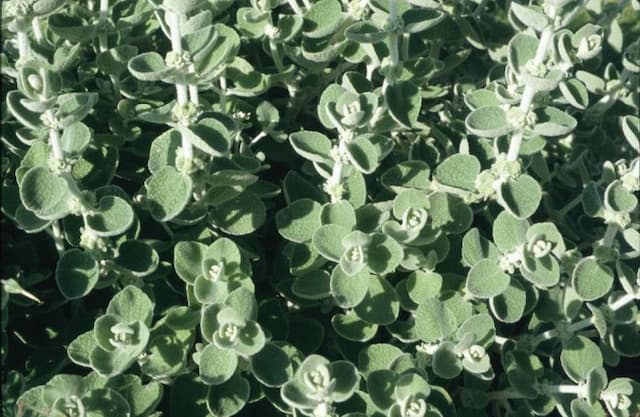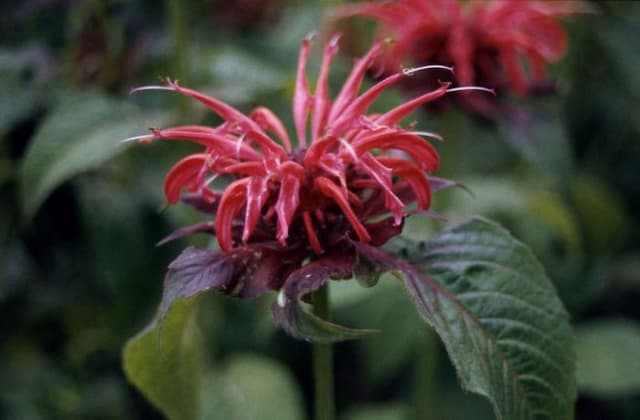Baby Sage Salvia microphylla var. microphylla 'Newby Hall'

ABOUT
The plant called 'Newby Hall', a variety of baby sage, features small, oval to lance-shaped leaves with a pleasant fragrance when brushed or crushed. The foliage is typically green, providing a lush backdrop for the flowers. Blooming prolifically, this plant produces striking, tubular flowers that can vary in shades of pink to occasionally light red. The flowers are arranged in whorls along upright stems and are a favorite for attracting hummingbirds and butterflies to the garden. The blooms typically last a long time, with the flowering season extending through warm months. Its overall form is rounded and bushy, presenting a dense and full silhouette that is rich in texture. The small leaves and abundant, brightly colored flowers combine to create a visually stunning and aromatic presentation.
About this plant
 Names
NamesFamily
Lamiaceae.
Synonyms
Baby Sage, Graham's Sage, Blackcurrant Sage, Newby Hall Sage.
Common names
Salvia microphylla var. microphylla 'Newby Hall'.
 Toxicity
ToxicityTo humans
Baby Sage, as Salvia microphylla is commonly known, is not typically toxic to humans. It is often used in culinary applications and herbal medicine. However, as with any plant, individual allergic reactions are possible. If you suspect an allergy or have adverse effects after handling or ingesting Baby Sage, seek medical advice. But generally, the plant is considered safe and non-toxic when used appropriately.
To pets
Baby Sage is also not commonly known to be toxic to pets. It's often grown in gardens where pets have access with no adverse effects reported. As with humans, sensitivity in individual animals can occur. Watch for signs of gastrointestinal upset or allergic reactions in your pet, and if such symptoms arise, consult your veterinarian. However, it is deemed to be relatively safe for pets in normal environmental exposure.
 Characteristics
CharacteristicsLife cycle
Perennials
Foliage type
Evergreen
Color of leaves
Green
Flower color
Pink
Height
2-3 feet (60-90 cm)
Spread
2-4 feet (60-120 cm)
Plant type
Shrub
Hardiness zones
7
Native area
Mexico
Benefits
 General Benefits
General Benefits- Attracts pollinators: Salvia microphylla 'Newby Hall', commonly known as Baby Sage or Hot Lips, attracts bees, butterflies, and hummingbirds, which are essential for the pollination of many plants.
- Aesthetic appeal: With its attractive red and white flowers, Baby Sage provides vibrant color and visual interest to any garden or landscape.
- Drought tolerance: Once established, Baby Sage is known for its drought resistance, making it suitable for gardens in arid or water-restricted areas.
- Low maintenance: This plant typically requires minimal care, making it a convenient choice for busy gardeners or those new to gardening.
- Aromatic foliage: The leaves of Baby Sage are aromatic when crushed or brushed against, releasing a pleasant fragrance and adding another sensory dimension to the garden.
- Deer resistant: Baby Sage is generally resistant to deer, which can be beneficial in areas where deer browsing is a concern for gardeners.
 Medical Properties
Medical PropertiesThis plant is not used for medical purposes.
 Air-purifying Qualities
Air-purifying QualitiesThis plant is not specifically known for air purifying qualities.
 Other Uses
Other Uses- Artisanal Honey Production: The nectar-rich flowers of baby sage can attract bees, which can produce honey with a unique flavor influenced by the plant's nectar.
- Culinary Garnish: The flowers and mild young leaves of baby sage can be used as an edible garnish for cakes and desserts for both visual appeal and a hint of sage flavor.
- Eco-friendly Dye: The leaves and flowers of baby sage can be boiled to produce a natural dye for fabrics or crafting materials, yielding subtle green to yellow hues.
- Crafting Potpourris: Dried leaves and flowers of baby sage can be included in potpourri mixes for their fragrance and their ability to retain color.
- Horticultural Therapy: Baby sage's easy cultivation and pleasant scent make it suitable for use in horticultural therapy programs to foster a nurturing environment.
- Fragrance Infusion: The aromatic leaves of baby sage can be used to infuse oils or waters to create natural room sprays or perfume bases.
- Photography Subject: With its vibrant flowers, baby sage is a photogenic plant that can be the centerpiece in garden and plant photography.
- Floral Arrangements: Baby sage's flowers can contribute to floral arrangements, providing long-lasting color and a pleasant sage aroma.
- Natural Mulch: When pruned, the leaves and stems of baby sage can be used as a natural mulch, providing nutrients to the soil as they decompose.
- Education and Research: Baby sage provides an opportunity for educational gardens and research on pollinator plant interactions, given its attractiveness to bees and butterflies.
Interesting Facts
 Feng Shui
Feng ShuiThe Baby Sage is not used in Feng Shui practice.
 Zodiac Sign Compitability
Zodiac Sign CompitabilityThe Baby Sage is not used in astrology practice.
 Plant Symbolism
Plant Symbolism- Wisdom: The genus Salvia is derived from the Latin word 'salvere' meaning 'to save' or 'to heal,' symbolizing wisdom and immortality.
- Longevity: Many varieties of Salvia are known for their long-lasting properties, both medicinally and decoratively, signifying a durable life.
- Healing: Salvia plants are often associated with various healing properties due to their use in traditional medicine, denoting physical and emotional healing.
- Purity: The distinct and clean aroma of some Salvia species can be associated with purity and the clearing of negative energies.
- Protection: Historically, Salvia has been used in spiritual and ritual practices for protection against evil and to promote a safe space.
 Water
WaterBaby Sage, also known by its botanical name Salvia microphylla 'Newby Hall', prefers moderate watering. During the growing season, water when the top inch of soil feels dry, which may be about once a week. Ensure the plant receives about one inch of water per week, which translates to roughly 0.623 gallons for an average-sized plant. Reduce frequency during winter months to prevent root rot, limiting watering to every two to three weeks, depending on the climate and indoor conditions. Always use a watering can or hose with a gentle flow to avoid soil erosion or damaging the plant's base.
 Light
LightBaby Sage thrives in full sun to partial shade. Place it in a location where it can receive at least six hours of direct sunlight each day. If it is grown indoors, a south-facing window would be the ideal spot to provide the ample light it requires for optimal growth and flowering. Avoid deep shade as it can lead to sparse foliage and fewer flowers.
 Temperature
TemperatureBaby Sage performs best in temperatures between 60°F and 85°F. It can tolerate minimum temperatures down to 20°F for short periods, making it suitable for USDA hardiness zones 7 to 9. Protect the plant from freezing temperatures to avoid damage to the leaves and stems. Ideal conditions are warm days and cool nights, typical of its natural habitat.
 Pruning
PruningPruning Baby Sage encourages bushier growth and more flowers. Prune lightly in early spring to shape the plant and remove any dead or damaged wood. After the first flush of blooms, trim the plant to encourage a second flowering. The best time to perform major pruning is after the last frost but before the plant starts its vigorous spring growth.
 Cleaning
CleaningAs needed
 Soil
SoilBaby Sage prefers a soil mix that drains well and is rich in organic matter, with a pH ranging from slightly acidic to neutral (pH 6.0 to 7.0). An ideal mix would be two parts garden soil, one part peat moss or coconut coir, and one part perlite or coarse sand to ensure good drainage.
 Repotting
RepottingBaby Sage should be repotted every 1-2 years or when it has outgrown its current container. The best time to repot is in the spring or early summer, giving the plant time to establish in warm growing conditions.
 Humidity & Misting
Humidity & MistingBaby Sage thrives in moderate humidity levels but is quite adaptable to different conditions. This plant does well in typical outdoor humidity and does not have specific high humidity requirements.
 Suitable locations
Suitable locationsIndoor
Place in bright, indirect light and ensure good air circulation.
Outdoor
Plant in well-draining soil, full sun to partial shade.
Hardiness zone
7-10 USDA
 Life cycle
Life cycleSalvia microphylla var. microphylla 'Newby Hall', commonly known as Baby Sage 'Newby Hall', begins its life cycle when its seeds germinate, typically in warm soil conditions, where the embryo inside the seed grows into a seedling. As the seedling establishes itself, it develops a root system and sprouts its first leaves, entering the vegetative stage where it focuses on growth and photosynthesis. Following the vegetative stage, the plant enters the flowering stage, usually in late spring to early summer, where it produces small, vibrant flowers that attract pollinators. After pollination, the plant sets seeds which are either dispersed by wind, animals, or self-sowing directly beneath the parent plant. Once the reproductive stage is complete and the seeds have spread, the plant may either die back depending on the climate (if it's in a colder climate and not perennial) or it may enter a period of dormancy in colder seasons, only to regrow from the rootstock the following spring. This cycle continues yearly as the plant lives its perennial life cycle, growing, flowering, seeding, and sometimes experiencing dormancy in colder climates until its lifespan is complete.
 Propogation
PropogationPropogation time
Spring-early summer
Salvia microphylla var. microphylla 'Newby Hall', commonly known as baby sage, is typically propagated through semi-ripe cuttings during summer, which is the most popular method due to its effectiveness and simplicity. To do this, a gardener would select healthy, non-flowering shoots and cut sections about 4 to 6 inches (10 to 15 centimeters) long. The lower leaves are removed, and the cut end dipped in rooting hormone to encourage root development. These prepared cuttings are then inserted into a mix of equal parts peat and coarse sand or perlite, which provides excellent drainage and air space for roots to form. The container with the cuttings should be kept in a warm place, out of direct sunlight, and the medium should remain moist but not waterlogged. Roots typically develop in a few weeks, after which the new plants can be gently removed and potted separately to grow on before planting out.









